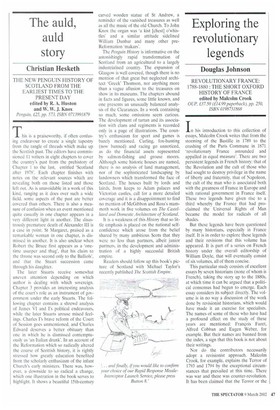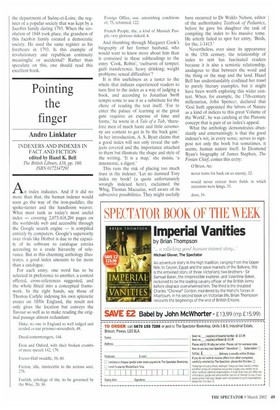Exploring the revolutionary legends
Douglas Johnson
REVOLUTIONARY FRANCE: 1788-1880 : THE SHORT OXFORD HISTORY OF FRANCE edited by Malcolm Crook
O(1P, L37.50 6E14.99 paperback), pp. 250, ISBN 0198731868
In his introduction to this collection of essays, Malcolm Crook writes that from the storming of the Bastille in 1789 to the crushing of the Paris Commune in 1871 'revolutionary France astounded and appalled in equal measure'. There are two persistent legends in French history: that of the Revolution and the cult of those who had sought to destroy privilege in the name of liberty and fraternity, that of Napoleon, the cult of the man who is associated both with the greatness of France in Europe and with rational government in France itself. These two legends have given rise to a third whereby the France that had proclaimed the Universal Rights of Man became the model for radicals of all shades.
But these legends have been questioned by many historians, especially in France itself. It is in order to explore these legends and their revisions that this volume has appeared. It is part of a series on French history under the overall editorship of William Doyle, that will eventually consist of six volumes, all of them concise.
This particular study consists of excellent essays by seven historians (none of whom is French), taking the story up to the 1880s, at which time it can be argued that a political consensus had begun to emerge. Each essay considers its subject directly. The volume is in no way a discussion of the work done by revisionist historians, which would have made it an exercise for specialists. The names of some of those who have had a profound effect on the study of these years are mentioned: Francois Furet, Alfred Cobban and Eugen Weber, for example. But their names are banned from the index, a sign that this book is not about their writings.
Nor do the contributors necessarily adopt a revisionist approach. Malcolm Crook, for example, explains the Terror of 1793 and 1794 by the exceptional circumstances that prevailed at this time. There was war and there was counter-revolution. It has been claimed that the Terror or the idea of the Terror was an essential part of the Revolution. Others see it as the work of a small group of men who were divided into mutually hostile factions, haunted by the fear of plots and conspiracies, But Crook does not consider these views. He also ignores certain recent views of the Revolution which make events in western France, in the Vendee, all-important and which use words that carry a particularly sinister meaning, such as genocide. He explains what happened in the Vendee when the so-called counter-revolution was crushed, but he gives equal importance to the furious repression that took place in the urban centres of the south and he quotes Fouche's proud boast, 'Lyons no longer exists.'
Thomas Kselman writes about the State and religion, explaining the institutional changes that took place and the role of the clergy, both in political circles and in their parishes. He goes on to consider the beliefs and behaviour of the ordinary citizen, not only because of the importance of the consumer but because the laity often exercised pressure on the clergy. The cult of saints, the creation of shrines, the growth of the idea of purgatory and the practice of spiritualism, all these developments had their role in other spheres, such as movements for social reform.
Elinor Accampo has the difficult task of writing about class and gender. She describes how the social system of the Ancien Regime depended upon the regulation of marriage, family life and the division of tasks in society. The Revolution created a new culture. Men no longer governed because of their aristocratic blood, so they had to show that they could govern properly, or, as is said, virtuously. But women, children and the poor could not be virtuous, they could not place the public good above private needs. And what happens in the period under review, what she calls 'the cycle of revolution and reaction', is a rethinking of gender and class distinctions. She concludes this stimulating article (accompanied by a rich bibliography) by suggesting that in this France was different from other modernising nations.
Peter McPhee's article on Town and Country will change many views. He suggests, and argues his case, that some historians have misrepresented relations between town and country because they have used documents which come from an urban-based bureaucracy that knew little about rural people. His article traces the ways in which those inhabiting the countryside changed in their attitudes to the nation and how towns developed in their attitude to the countryside.
Robert Gildea also studies the provinces and localities in a France which had been put together, as he says, 'like a mosaic, piece by piece'. His account of centralisation, and of opposition to it, proceeds to consideration of France as `la patrie', the fatherland for which the French were prepared to die. He shows how from the time of the Revolution France was not a beacon of liberty but a power fighting for survival in a European conflict. The climax came with the defeat of France in the FrancoPrussian war of 1870. So great was this national catastrophe that when French leaders wanted to expand French territory and acquire colonies there were those who opposed this because it was a weakening of French forces which should have been preparing for a war of revenge against Germany. But France did acquire an empire, notably Algeria after 1830, as is shown by Michael Heffernan, who is conscious of the many immigrants in France today who have roots in former colonial territories.
Perhaps the most difficult task was given to Pamela Pilbeam who, in the second chapter of this book, had to describe and explain what she calls 'the cascade of revolutions' that took place between 1814 and 1880. Not only does she discuss 1830, 1848 and 1871 but she considers the themes that are relevant to this history, such as monarchy. republicanism, Bonapartism, socialism and the role of towns. She concludes by asking whether the revolutions really were revolutions.
One is obliged to wonder whether there was any continuity in people's views of revolution. Quite by accident a French historian has discovered at Paray-le-Monial, in the department of Saone-et-Loire, the register of a popular society that was kept by a Jacobin family during 1793. When the revolution of 1848 took place, the grandson of this Jacobin family created a democratic society. He used the same register as his forebears in 1793. Is this example of revolutionary and republican continuity meaningful or accidental? Rather than speculate on this, one should read this excellent book.
















































































 Previous page
Previous page